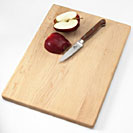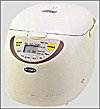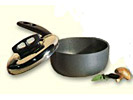Trying to cook in other people's kitchens is always an interesting experience. We have often found ourselves not used to the knives, pots and pans, and other related cookware. Here we have described what we currently use on a regular basis, and we would welcome conversation on what other people find essential to their kitchen. We split the cookware into three categories: preparation, cooking, and serving.
Preparation:
![]() For all-purpose
cutting and chopping, we most often use a French
cleaver. A serrated blade just
doesn't work that well for most of the things we cook.
A French cleaver should be well-balanced and have a
reasonable heft to it. We use two: one from
Chicago Cutlery that we've had since college, and a Wüsthof French cleaver that we got from our wedding
registry. Both hold an edge well and have worked
well. We also have a French cleaver from Oxo, and
it also works well, but the balance seems a bit off.
If we were buying a brand new knife today, it would
probably be one from Wüsthof or maybe J. A. Henckels.
For all-purpose
cutting and chopping, we most often use a French
cleaver. A serrated blade just
doesn't work that well for most of the things we cook.
A French cleaver should be well-balanced and have a
reasonable heft to it. We use two: one from
Chicago Cutlery that we've had since college, and a Wüsthof French cleaver that we got from our wedding
registry. Both hold an edge well and have worked
well. We also have a French cleaver from Oxo, and
it also works well, but the balance seems a bit off.
If we were buying a brand new knife today, it would
probably be one from Wüsthof or maybe J. A. Henckels.
A French cleaver should be held with the thumb and fore-finger gripping the blade and the remaining three fingers on the handle. One should never scrape a cutting board sideways with the blade to gather together what one has cut. Dragging a blade sideways can dull it's edge quickly. Instead, one can flip the blade over and use the back of the knife.
As a side note, the wide blade of a French cleaver has advantages over a thinner knife in that it is easier to use the flat part of the knife to crush garlic. Once you press down or smack a clove of garlic, it easily separates from its skin.
 Aside from a good knife, the second most important piece
of preparation equipment is a good cutting board.
A lot of Chinese cooking requires a lot of cutting, and
relatively little actual cooking time. We prefer
wood cutting boards. It allows the knife to bite
into the board just a little bit, which helps to ensure
a clean cut. It can be frustrating to chop up some
scallions only to find that none of the slices went all
the way through.
Aside from a good knife, the second most important piece
of preparation equipment is a good cutting board.
A lot of Chinese cooking requires a lot of cutting, and
relatively little actual cooking time. We prefer
wood cutting boards. It allows the knife to bite
into the board just a little bit, which helps to ensure
a clean cut. It can be frustrating to chop up some
scallions only to find that none of the slices went all
the way through.
We use two cutting boards: one for raw meat, and the other for everything else. They are 10" x 14" and we wash and dry them immediately after use. Some people voice concerns about the accumulation of bacteria on wood cutting boards, but there are techniques for fighting bacteria on the boards.
When buying a cutting board, one should look for boards that are made of fewer pieces. We have had one cutting board that split because it was glued together in the direction that we did most of our cutting.
 We
use a set of four cereal bowls to contain the
ingredients we prepare. We've found that a cereal
bowl is a good size for marinating some meat and
containing some chopped vegetables. Our handsome
set of four black bowls comes from Albert's college
dishware collection.
We
use a set of four cereal bowls to contain the
ingredients we prepare. We've found that a cereal
bowl is a good size for marinating some meat and
containing some chopped vegetables. Our handsome
set of four black bowls comes from Albert's college
dishware collection.
 The Oxo Good Grips vegetable peeler is simply a great
vegetable peeler.
The Oxo Good Grips vegetable peeler is simply a great
vegetable peeler.
Cooking:
 The majority of our cooking is done in a flat bottom
12-inch non-stick wok. It's great for stir-frying
most things. It also works for making fried rice,
porridge and many other dishes. The one we have is
from Wearever. Our wok has a fairly thick bottom,
which allows it to heat evenly. We find it much
harder to control heat with thin-bottomed pots and pans.
The majority of our cooking is done in a flat bottom
12-inch non-stick wok. It's great for stir-frying
most things. It also works for making fried rice,
porridge and many other dishes. The one we have is
from Wearever. Our wok has a fairly thick bottom,
which allows it to heat evenly. We find it much
harder to control heat with thin-bottomed pots and pans.
 Our two quart pot is used for steaming vegetables, and
it's a great size for cooking ramen. Our two quart
pot is non-stick and is made by Wearever. We've
left it on the stove many times until the pot was
charred, but it continues to work well. We've had
it since college.
Our two quart pot is used for steaming vegetables, and
it's a great size for cooking ramen. Our two quart
pot is non-stick and is made by Wearever. We've
left it on the stove many times until the pot was
charred, but it continues to work well. We've had
it since college.
Our three quart pot is a little small for cooking pasta, but that's what we use it for. Pasta should really be cooked in a pot which allows one to use 6 quarts of water for every pound of pasta. For one meal, we'll cook half a pound of pasta. We also use this pot for cooking ramen as well. Our three quart pot is non-stick and is made by Wearever.
 Our five quart pot is the final piece of our commonly
used set of pots and pans. It is large enough to
cook soups and stews and to steam an occasional lobster.
The main dish we cook in this pot is minestrone soup,
which uses 8 cups of water and a ton of vegetables.
Our five quart pot is stainless steel and is made by
RangeCraft.
Our five quart pot is the final piece of our commonly
used set of pots and pans. It is large enough to
cook soups and stews and to steam an occasional lobster.
The main dish we cook in this pot is minestrone soup,
which uses 8 cups of water and a ton of vegetables.
Our five quart pot is stainless steel and is made by
RangeCraft.
 Our one olive wood spatula is what we use for the
majority of our cooking. Though modern non-stick
surfaces are scratch-resistant, we originally started
using a wood spatula to protect our older non-stick pots
and pans. The one
disadvantage of the wooden spatula is that it's not good
for things like flipping pancakes. It is just too
straight for that purpose. On the other hand, one
can always flip pancakes with the pan alone.
Our one olive wood spatula is what we use for the
majority of our cooking. Though modern non-stick
surfaces are scratch-resistant, we originally started
using a wood spatula to protect our older non-stick pots
and pans. The one
disadvantage of the wooden spatula is that it's not good
for things like flipping pancakes. It is just too
straight for that purpose. On the other hand, one
can always flip pancakes with the pan alone.
 Philana
gave us the excellent Tiger brand rice cooker
we currently use (Thanks, Philana!). After dealing for years with a
rice cooker that required extensive soaking to clean, we
are gratified to have one with a non-stick surface that
really works. The only problem is all of the
buttons are labeled in Chinese and it takes us about 15
minutes every time we try to determine the right button
combination to allow us to set the clock.
Philana
gave us the excellent Tiger brand rice cooker
we currently use (Thanks, Philana!). After dealing for years with a
rice cooker that required extensive soaking to clean, we
are gratified to have one with a non-stick surface that
really works. The only problem is all of the
buttons are labeled in Chinese and it takes us about 15
minutes every time we try to determine the right button
combination to allow us to set the clock.
 While steamed vegetables can be drained by pouring the
water out with the lid on the pot, things like pasta
need to be drained through a colander. The sturdy
plastic Rubbermaid colander we use works better than metal sieves
we've tried in the past.
While steamed vegetables can be drained by pouring the
water out with the lid on the pot, things like pasta
need to be drained through a colander. The sturdy
plastic Rubbermaid colander we use works better than metal sieves
we've tried in the past.
Serving:
 Although we do
have a set of plates and serving dishes, by far the
majority of our meals are eaten in two large bowls.
They are large enough to put in rice plus a dish served
on top; to have ramen or other kinds of noodle soup; or
to have a stew. There can be something comforting
about having one big bowl of food. Yoshinoya's
beef bowl and Taco Bell's fiesta bowl are fast-food
equivalents of the same concept.
Although we do
have a set of plates and serving dishes, by far the
majority of our meals are eaten in two large bowls.
They are large enough to put in rice plus a dish served
on top; to have ramen or other kinds of noodle soup; or
to have a stew. There can be something comforting
about having one big bowl of food. Yoshinoya's
beef bowl and Taco Bell's fiesta bowl are fast-food
equivalents of the same concept.

